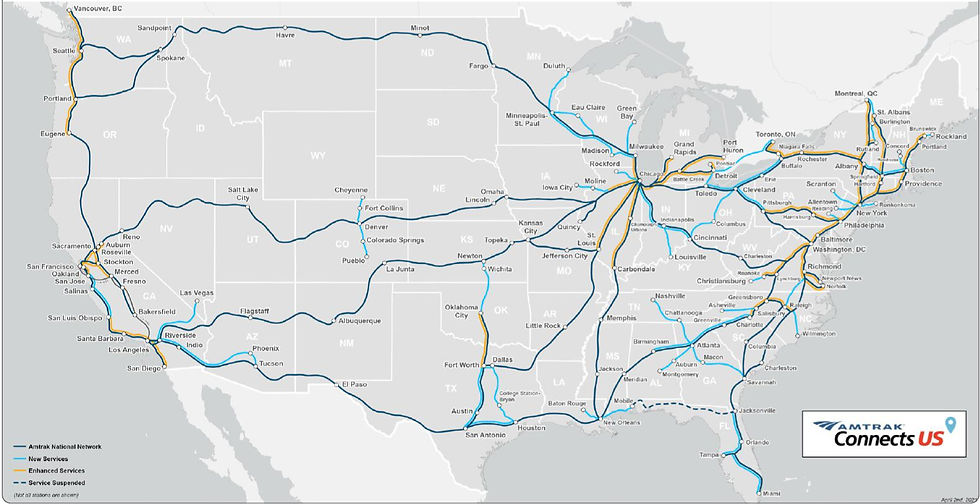Don’t Let Kansas Miss the Train: Why Passenger Rail Is the Right Move Right Now
- Deborah Fischer Stout

- Jan 17
- 3 min read
Updated: Feb 25
A Ticket to Prosperity: Kansas’ Second Chance at Passenger Rail
In a world increasingly defined by mobility, connectivity, and economic opportunity, Kansas once stood at the crossroads of America’s great railways. Passenger trains coursed through the heartland, binding communities together and fueling economic vitality. But decades of neglect and misplaced priorities have whittled away our once-proud rail infrastructure, leaving a void where opportunity once roared.
Last year, however, marked a turning point. In an act of foresight and leadership, the Kansas Legislature made a vital investment in the Passenger Rail Revolving Fund, allocating $5 million toward expanding our state’s passenger rail system. This historic move was more than a nod to nostalgia; it was a calculated bet on Kansas’ future.
Passenger rail represents more than transportation. It is an engine of economic growth, a steward of environmental responsibility, and a lifeline for communities striving to stay connected in an age of urban sprawl and rural isolation.
The Cost of Delay: Why We Must Act Now
If you’re waiting for the “perfect time” to restore Kansas’ passenger rail network, I have bad news: it was over a decade ago. In 2011, we had a chance to bring three trains per day to our state for $430 million. Today, a single train per day will cost $573 million (after an 80% federal match, Kansas would pay $58M). This staggering increase—a 4-fold rise in cost every decade—is the price of delay.
All forms of transportation are expensive, which means every year of inaction is an act of unnecessarily increasing costs to Kansans, not to mention the economic and environmental opportunities lost. This isn’t just an abstract budget issue; it’s a failure of foresight that threatens the state’s ability to compete regionally and nationally.
Legislators and the Kansas Department of Transportation (KDOT) must stop kicking the can down the road.
Why Rail, Why Now?
Investing in passenger rail expansion in Kansas isn’t merely an exercise in infrastructure improvement; it’s an investment in prosperity. The return is immediate and multifaceted:
Economic Growth: Restored rail lines connect smaller towns to hubs of commerce, drawing new business and tourism while cutting costs for daily commuters. Studies show regions with robust rail systems see a surge in local revenue and property values.
Environmental Stewardship: Trains are far more energy-efficient than cars or planes, offering a sustainable alternative for transportation that helps Kansas do its part to combat climate change.
Accessibility: For seniors, students, and those without reliable access to cars, passenger rail offers the kind of freedom once relegated to major metropolitan areas.
Productivity for Business Travelers: Unlike driving or flying, passenger rail offers business travelers the unique opportunity to remain productive while in transit. Spacious seating, reliable Wi-Fi, and the ability to work comfortably using electronic devices mean time spent on the train is time well used.
What You Can Do
Momentum is on our side, but legislative success requires civic engagement. Here are two simple yet powerful actions you can take today:
Contact Your State Legislator: Legislators listen when citizens speak up. Take five minutes to write, call, or email your representatives and KDOT. Demand they act now to expand Kansas’ passenger rail system and stop unnecessary delays. Every year we wait increases the financial and economic cost to our state. You can find your legislator here: Find Your Legislator
Donate to the Cause: The Northern Flyer Alliance has been at the forefront of this fight, advocating tirelessly for rail development in our region. Your donation, no matter the size, enables us to conduct research, engage communities, and make the case to policymakers that this cause is worth fighting for.
Final Thoughts
Kansas has a choice to make. It can either remain a bystander to the transformative changes that passenger rail offers or seize this opportunity to lead by example. Our neighbors in Missouri, Colorado, and Texas are not waiting to connect their cities and grow their economies. Neither should we.
Support for passenger rail is not just a commitment to a mode of transportation; it is a declaration of hope for Kansas’ future. So today, lend your voice, open your wallet, and stand for the progress this state so desperately needs. Together, we can ensure the steady hum of passenger trains rolling across the heartland becomes a defining feature of Kansas once again—not as a memory of the past but as a herald of a brighter, more connected tomorrow.










Comments